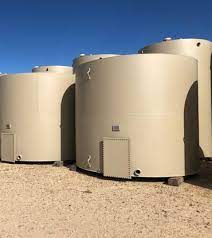
I remember this story. Kids played on tanks and then one day a young girl was killed when one exploded.
State regulators are giving oil companies notice that they’ll soon be cracking down on storage tanks that may trigger accidents like the one that killed a teenager in southwest Louisiana last year. The state Department of Natural Resources has identified 1,400 tank battery sites that will likely need to follow new safety rules established after the death of Zalee Gail Day-Smith, a 14-year-old girl who State Police investigators believe was sitting on a tank in Beauregard Parish when it exploded on Feb. 28, 2021. The new rules, which took effect early this year, require fencing, locked gates, warning signs and sealed tank hatches at sites in populated areas, which the state defines as within 500 feet of a home or highway, 1,000 feet of a church or school, or anywhere within the limits of a city or town. State officials admit they weren’t keeping close tabs on the sites. “For more than a century, these tank battery facilities were not being tracked individually,” said Richard Ieyoub, the state conservation commissioner and Louisiana’s former attorney general.. Instead, the sites were treated as an extension of wells sites and only noted in inspections if there was a spill or other reported problem.
nola.com

DNR has been looking at maps and visuals to see the tanks near people.
DNR’s Office of Conservation spent most of the past year locating tank site records and then determining via aerial maps if the sites were within city limits or near homes, schools, churches and highways. “It is never easy to take on a project like this, when you are doing something that probably should have been done decades ago, but when we see a safety issue, we have to do what we can to address it,” Ieyoub said. Notices are now going out to the owners of the 1,400 sites that fit the criteria for the new rules. An owner must now prove that the rules either don’t apply to their site or demonstrate with photos and other evidence that they are complying with the rules. DNR has no plans to do followup inspections beyond routine ones already conducted by inspectors.

U.S. Fish and Wildlife Service
These tank batteries are not connected to a well and have been left when the well was no longer used. The companies should have cleaned them up when they left.
Tank batteries are oil well storage sites that are not connected to a major pipeline. The tanks are large metal containers that may hold thousands of gallons of crude oil. The oil releases fumes that a mere spark can turn explosive. Day-Smith and other neighborhood children frequented an oil tank battery a few hundred feet from Day-Smith’s mother’s house in Ragley, a small community about 17 miles north of Lake Charles. While the last wells that the battery served had been shut down about a year earlier, the tanks held about 8,000 gallons of oil, according to DNR. It’s unclear what triggered the explosion that killed Day-Smith, whose family said she dreamed of studying at Harvard University and working as a lawyer. One resident who lived near the site said the blast sent a “fireball” into the air and knocked him to the ground. The tank battery’s owner, Urban Oil and Gas of Plano, Texas, has defended its safety record and noted that warning signs were posted at the site, but declined further comment.

The dangers have been known but often the fences surrounding them have failed.
The dangers of tank batteries have been well documented. A Chemical Safety Board report identified 44 deaths and 25 injuries at oil storage sites in the U.S. between 1983 and 2010. All the victims were under 25. Many teenagers living near oil storage sites said they liked to socialize and “hang out” at the sites, according to the 2011 report. The sites are often away from public view, unfenced and lack warning signs, the report said. DNR staff said Louisiana residents’ awareness of the dangers posed by oil storage tanks has waned as the industry declined. While many sites fall into disuse or are abandoned, the risks often remain. Last year’s Infrastructure Investment and Jobs Act put more than $1 billion toward plugging and remediating “orphan” wells across the country. Sites are classified as “orphaned” when the wells are no longer used and their operators have gone bankrupt, can’t be located, or are unable or unwilling to maintain their sites. Many of these sites include tank batteries. The act directed about $25 million to DNR tackle a few hundred abandoned well sites in north Louisiana. DNR will also administer almost $13 million for wells left to rust in five national wildlife refuges. DNR has documented about 4,600 orphan wells, but the actual number is likely much larger and expected to rise as small and mid-sized companies shut down and the industry shifts to larger, cheaper sources of fossil fuel outside the state.
How many problems does this state have because they let the oil and gas industry to get away from from the damages they have caused.


